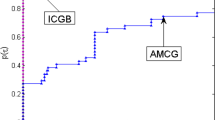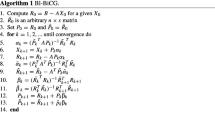Abstract
The Bi-Conjugate Gradient (BCG) algorithm is the simplest and most natural generalization of the classical conjugate gradient method for solving nonsymmetric linear systems. It is well-known that the method suffers from two kinds of breakdowns. The first is due to the breakdown of the underlying Lanczos process and the second is due to the fact that some iterates are not well-defined by the Galerkin condition on the associated Krylov subspaces. In this paper, we derive a simple modification of the BCG algorithm, the Composite Step BCG (CSBCG) algorithm, which is able to compute all the well-defined BCG iterates stably, assuming that the underlying Lanczos process does not break down. The main idea is to skip over a step for which the BCG iterate is not defined.
Similar content being viewed by others
References
R. Bank and T. Chan, An analysis of the composite step biconjugate gradient method, Numer. Math. 66 (1993) 295–319.
C. Brezinski, M.R. Zaglia and H. Sadok, Avoiding breakdown and near-breakdown in Lanczos type algorithms, Numer. Algor. 1 (1991) 261–284.
C. Brezenski, M.R. Zaglia and H. Sadok, Addendum to: Avoiding breakdown and nearbreakdown in Lanczos type algorithms, Numer. Algor. 2 (1992) 133–136.
C. Brezinski, M.R. Zaglia and H. Sadok, Breakdowns in the implementation of the Lanczos method for solving linear systems, Int. J. Math. Appl. (1994), to appear.
T. Chan, E. Gallopoulos, V. Simoncini, T. Szeto and C. Tong, QMRCGSTAB: A quasi-minimal residual version of the Bi-CGSTAB algorithm for nonsymmetric systems, Tech. Rep. CAM 92-26, UCLA, Dept. of Math., Los Angeles, CA 90024-1555 (1992), to appear in SIAM J. Sci. Comp.
T.F. Chan and T. Szeto, A composite step conjugate gradients squared algorithm for solving nonsymmetric linear systems, Numer. Algor. (1994), this issue.
A. Draux,Polynômes Orthogonaux Formels. Applications, Lect. Notes in Mathematics, vol. 974 (Springer, Berlin, 1983).
V. Faber and T. Manteuffel, Necessary and sufficient conditions for the existence of a conjugate gradient method, SIAM J. Numer. Anal. 21 (1984) 315–339.
R. Fletcher, Conjugate gradient methods for indefinite systems, in:Numerical Analysis Dundee 1975, Lecture Notes in Mathematics 506, ed. G.A. Watson (Springer, Berlin, 1976) pp. 73–89.
R.W. Freund, A transpose-free quasi-minimum residual algorithm for non-Hermitian linear systems, SIAM J. Sci. Comp. 14 (1993) 470–482.
R.W. Freund, M.H. Gutknecht and N.M. Nachtigal, An implementation of the look-ahead Lanczos algorithm for non-Hermitian matrices, SIAM J. Sci. Comp. 14 (1993) 137–158.
R.W. Freund and N.M. Nachtigal, QMR: quasi residual residual method for non-Hermitian linear systems, Numer. Math. 60 (1991) 315–339.
M. Gutknecht, A completed theory of the unsymmetric Lanczos process and related algorithms, Part I, SIAM J. Matrix Anal. 13 (1992) 594–639.
W. Joubert, Generalized conjugate gradient and Lanczos methods for the solution of non-symmetric systems of linear equations, PhD thesis, Univ. of Texas at Austin (1990).
C. Lanczos, Solution of linear equations by minimized iterations, J. Res. Natl. Bar. Stand. 49 (1952) 33–53.
D. Luenberger, Hyperbolic pairs in the method of conjugate gradients, SIAM J. Appl. Math. 17 (1969) 1263–1267.
N. Nachtigal, S. Reddy and L. Trefethen, How fast are nonsymmetric matrix iterations?, SIAM J. Matrix Anal. 13 (1992) 778–795.
C.C. Paige and M.A. Saunders, Solution of sparse indefinite systems of linear equations, SIAM J. Numer. Anal. 12 (1975) 617–629.
Y. Saad, The Lanczos biorthogonalization algorithm and other oblique projection methods for solving large unsymmetric systems, SIAM J. Numer. Anal. 19 (1982) 485–506.
M. Schultz and Y. Saad, GMRES: a generalized minimal residual algorithm for solving non-symmetric linear systems, SIAM J. Sci. Stat. Comp. 7 (1986) 856–869.
P. Sonneveld, CGS, a fast Lanczos-type solver for nonsymmetric linear systems, SIAM J. Sci. Stat. Comp. 10 (1989) 36–52.
C.H. Tong, A comparative study of preconditioned Lanczos methods for nonsymmetric linear systems, Tech. Rep. SAND91-8402 UC-404, Sandia National Laboratories, Albuquerque (1992).
H.A. Van Der Vorst, BI-CGSTAB: A fast and smoothly converging varient of BI-CG for the solution of nonsymmetric linear systems, SIAM J. Sci. Comp. 13 (1992) 631–644.
Author information
Authors and Affiliations
Additional information
Communicated by C. Brezinski
The work of this author was supported by the Office of Naval Research under contract N00014-89J-1440.
The work of this author was supported by the Office of Naval Research under contracts N00014-90J-1695 and N00014-92J-1890, the Department of Energy under contract DE-FG03-87ER25307, the National Science Foundation under contracts ASC 90-03002 and 92-01266, and the Army Research Office under contract DAAL03-91-G-0150. Part of this work was completed during a visit to the Computer Science Dept., The Chinese University of Hong Kong.
Rights and permissions
About this article
Cite this article
Bank, R.E., Chan, T.F. A composite step bi-conjugate gradient algorithm for nonsymmetric linear systems. Numer Algor 7, 1–16 (1994). https://doi.org/10.1007/BF02141258
Received:
Revised:
Issue Date:
DOI: https://doi.org/10.1007/BF02141258




